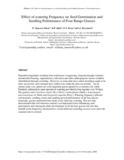| dc.identifier.citation | Mnene, W. N., Ogillo, B. P., Ekaya, W. N., & Kinyamario, J. I.,2008. Effect of watering Frequency on Seed Germination and Seedling Performance of Four Range Grasses. | en_US |
| dc.description.abstract | Degraded rangelands resulting from continuous overgrazing, frequent drought, termites,
uncontrolled burning, opportunistic cultivation and other anthropogenic factors could be
rehabilitated through reseeding. However, in semi-arid areas where reseeding ought to be
more successful, such attempts have failed even when the rains are normal. An onstation
study was carried out with rangeland grasses potted in a common soil, orthic
Ferralsol, subjected to same amount of watering provided in four regimes over 70 days.
The grasses were Cenchrus ciliaris (L), Chloris roxburghiana (Shult.), Enteropogon
macrostachyus (A. Rich) and Eragrostis superba (Peyr.). Watering frequency affected
soil moisture, seedling counts and seedling growth performance of all four species.
Generally, grasses performed best under every third day watering. This not only
demonstrated that soil moisture content is an important factor influencing seed
germination and subsequent plant development of all the four grasses but also that
rainfall storm frequency characteristics would influence reseeding success even when the
seasonal total is normal. | en_US |


